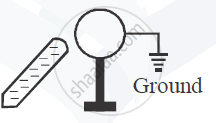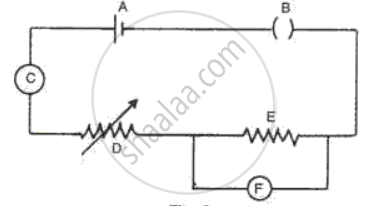Advertisements
Advertisements
प्रश्न
Answer the following question.
Distinguish between Ohmic and non-ohmic substances; explain with the help of example.
उत्तर
| Ohmic substances | Non-ohmic substances |
| 1. Substances which obey ohm’s law are called ohmic substances | 1. Substances which do not obey ohm’s law are called non-ohmic substances. |
| 2. Potential difference (V) versus current (I) curve is a straight line. | 2. Potential difference (V) versus current (I) curve is not a straight line. |
| 3. Resistance of these substances is constant i.e. they follow linear I-V characteristic. | 3. Resistance of these substances is a function of V or I. |
| 4. Expression for resistance is, R = `"V"/"I"` | 4. Expression for resistance is, R = `lim_(Δ"l"→0)(Δ"V")/(Δ"I")="dV"/"dI"` |
| 5. Examples: Gold, silver, copper etc. | 5. Examples: Liquid electrolytes, vacuum tubes, junction diodes, thermistors etc. |
APPEARS IN
संबंधित प्रश्न
If the potential difference across the ends of a conductor is 220 V and the resistance of the conductor is 44 Ω (ohm), then the current flowing through is _________.
- 0.2 A
- 0.5 A
- 2 A
- 5 A
Let the resistance of an electrical component remains constant while the potential difference across the two ends of the component decreases to half of its former value. What change will occur in the current through it?
When a 12 V battery is connected across an unknown resistor, there is a current of 2.5 mA in the circuit. Find the value of the resistance of the resistor.
Name the unit of electrical resistance and give its symbol.
When a 12 V battery is connected across an unknown resistor, there is a current of 2.5 mA in the circuit. Calculate the value of the resistance of the resistor.
The graph between V and I for a conductor is a straight line passing through the origin.
Which law is illustrated by such a graph?
The graph between V and I for a conductor is a straight line passing through the origin.
What should remain constant in a statement of this law?
How much energy is consumed when a current of 5 amperes flows through the filament (or element) of a heater having resistance of 100 ohms for two hours? Express it in joules.
State Ohm’s law and draw a neat labelled circuit diagram containing a battery, a key, a voltmeter, an ammeter, a rheostat and an unknown resistance to verify it.
In a conductor 6.25 × `10^16` electrons flow from its end A to B in 2 s. Find the current flowing through the conductor (e = 1.6 × `10^-19` C)
A wire of resistance 9 ohm having length 30 cm is tripled on itself. What is its new resistance?
How does an increase in the temperature affect the specific resistance of a :
(i) Metal and
(ii) Semiconductor ?
A metal sphere is kept on an insulting stands. A negatively charged rod is brought near it, then the sphere is earthed as shown. On removing the earthing, and taking the negatively charged rod away, what will be the nature of charge on the sphere? Give reason for your answer.

Fig. represents the circuit used for the verification of Ohm's law. Label the parts from A to F. state the function of each.

Rewrite the following statement by selecting the correct option.
The S.I. unit of resistance is __________.
State the relation correlating the electric current flowing in a conductor and the voltage applied across it. Also, draw a graph to show this. relationship.
What is non-ohmic resistor?
What are non-ohmic conductors? Give one exmaple. Draw a current-voltage graph for a non-ohmic conductor.
Choose the correct alternative.
Which of the following is an ohmic conductor?
State microscopic form of Ohm’s law.
What is ohmic device?
The variable resistance is called ____________.
Assertion: The statement of Ohm’s law is K = IR.
Reason: V = IR is the equation which defines resistance.
What is the resistance of a conductor through which a current of 0.5 A flows when a potential difference of 2V is applied across its ends?
You are provided with a resistor, a key, an ammeter, a voltmeter, four cells of 1.5 V each and few connecting wires. Using circuit components, draw a labelled circuit diagram to show the setup to study Ohm's law.
State the relationship between potential difference (V) across the resistor and the current (I) flowing through it. Also draw V-I graph, taking V on the X-axis.
Let the resistance of an electrical device remain constant, while the potential difference across its two ends decreases to one fourth of its initial value. What change will occur in the current through it? State the law which helps us in solving the above stated question.
What is meant by resistance of a conductor ? Define its SI unit.

Vinita and Ahmed demonstrated a circuit that operates the two headlights and the two sidelights of a car, in their school exhibition. Based on their demonstrated circuit, answer the following questions.
- State what happens when switch A is connected to:
a) Position 2
b) Position 3 - Find the potential difference across each lamp when lit.
- Calculate the current.
a) in each 12 Ω lamp when lit.
b) In each 4 Ω lamp when lit.
OR - Show, with calculations, which type of lamp, 4.0 Ω or 12 Ω, has the higher power.
A current of 3.2 mA flows through a conductor. If charge on an electron is - 1.6 × 10-19 coulomb, find the number of electrons that will pass each second through the cross section of that conductor.
